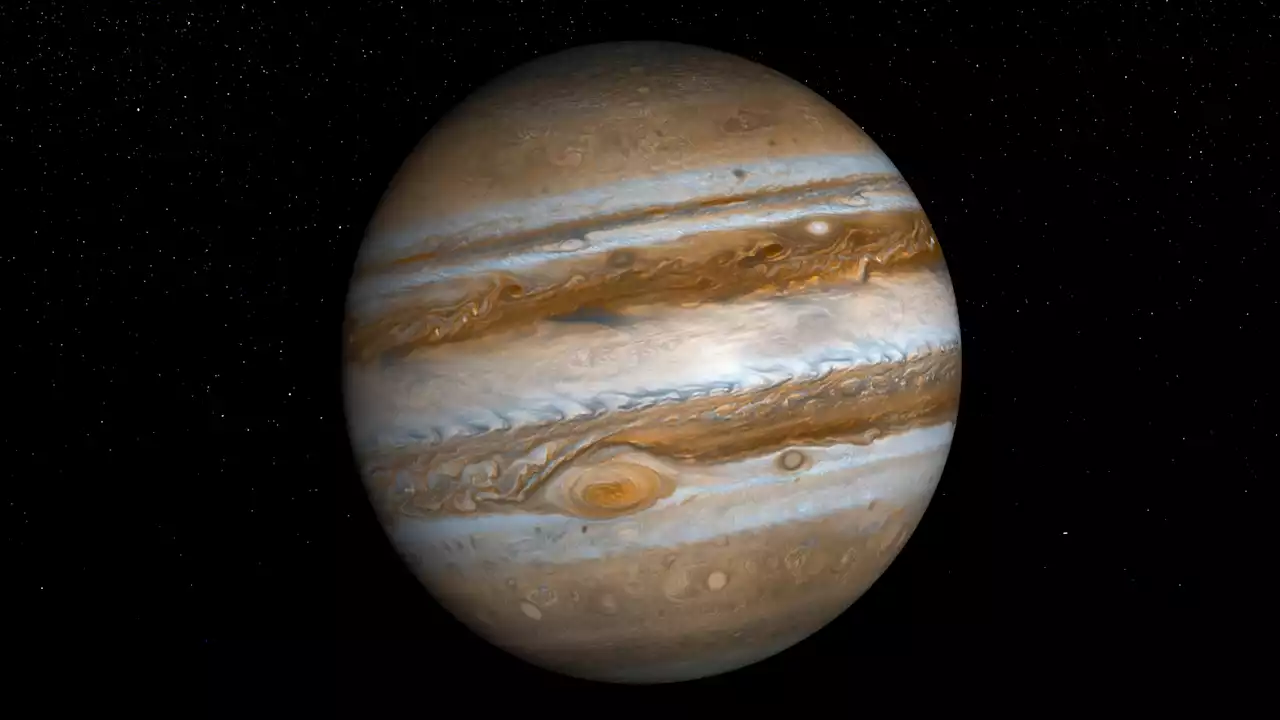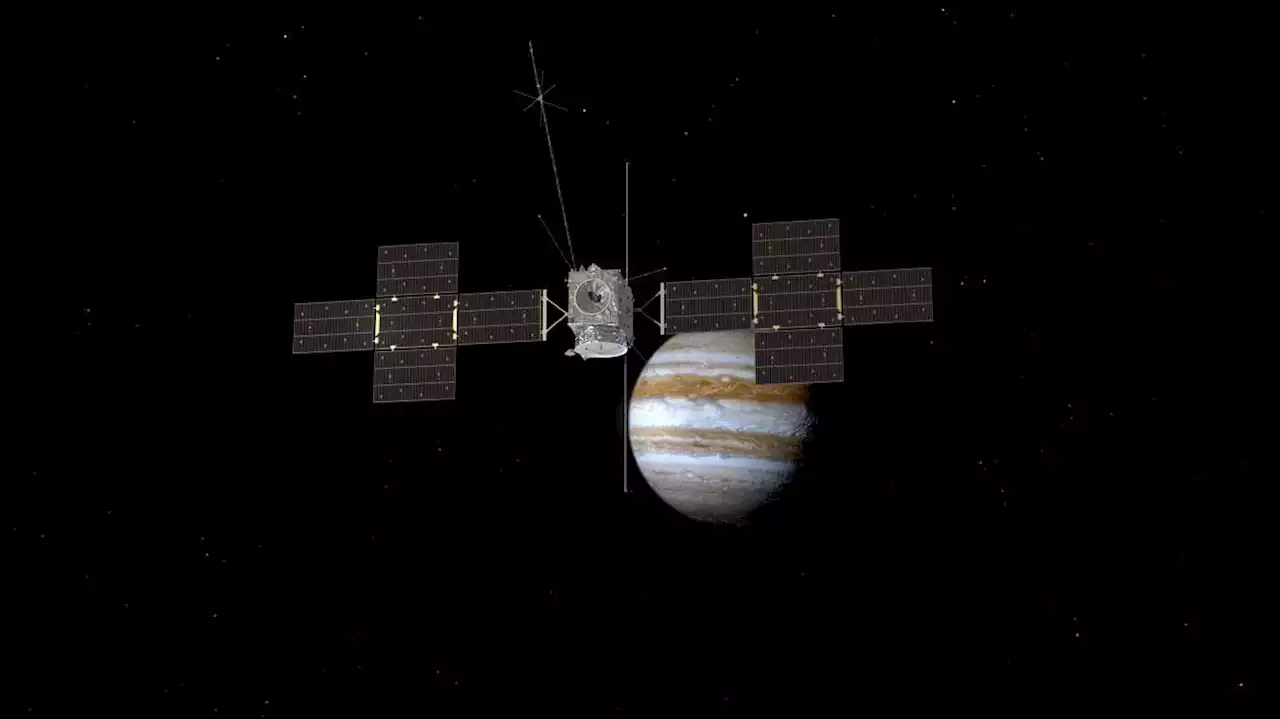A European spacecraft has blasted off on a quest to explore Jupiter and three of its ice-encrusted moons.
HOUSTON — A European spacecraft rocketed away Friday on a decadelong quest to explore Jupiter and three of its icy moons that could hold buried oceans.
It will take the robotic explorer, dubbed Juice, eight years to reach Jupiter, where it will scope out not only the solar system's biggest planet but also Europa, Callisto and Ganymede. The three ice-encrusted moons are believed to harbor underground oceans, where sea life could exist. "This is a mission that is answering questions of science that are burning to all of us," said European Space Agency's director general, Josef Aschbacher, after the launch. "Of course, one of these questions is: Is there life out there?"
Even more enticing, it's thought to have an underground ocean holding more water than Earth. Ditto for Europa and its reported geysers, and heavily cratered Callisto, a potential destination for humans given its distance from Jupiter's debilitating radiation belts, according to Carnegie Institution's Scott Sheppard, who's not involved with the Juice mission.
"These things take time — and they change our world," said the Planetary Society's chief executive, Bill Nye. The California-based space advocacy group organized a virtual watch party for the launch. Europa is especially attractive to scientists hunting for signs of life beyond Earth. Juice will keep its Europa encounters to a minimum, however, because of the intense radiation there so close to Jupiter.
Brasil Últimas Notícias, Brasil Manchetes
Similar News:Você também pode ler notícias semelhantes a esta que coletamos de outras fontes de notícias.
 European Spacecraft Launches on Quest to Explore Jupiter and Its Icy MoonsIt will take the robotic explorer, dubbed Juice, eight years to reach Jupiter, where it will scope out not only the solar system’s biggest planet but also Europa, Callisto and Ganymede.
European Spacecraft Launches on Quest to Explore Jupiter and Its Icy MoonsIt will take the robotic explorer, dubbed Juice, eight years to reach Jupiter, where it will scope out not only the solar system’s biggest planet but also Europa, Callisto and Ganymede.
Consulte Mais informação »
 European spacecraft rockets toward Jupiter and its icy moonsA European spacecraft has blasted off on a quest to explore Jupiter and three of its ice-encrusted moons. Dubbed Juice, the robotic explorer set off on an eight-year journey Friday from French Guiana in South America, launching atop an Ariane rocket. Juice is taking a long, roundabout route. It should reach Jupiter in 2031 and spend three years buzzing Callisto, Europa and Ganymede. Then it will attempt to enter orbit around Ganymede, our solar system's largest moon. The three moons are believed to harbor underground oceans, where sea life could exist. If underground seas are confirmed, ice picks and a submarine could be next up.
European spacecraft rockets toward Jupiter and its icy moonsA European spacecraft has blasted off on a quest to explore Jupiter and three of its ice-encrusted moons. Dubbed Juice, the robotic explorer set off on an eight-year journey Friday from French Guiana in South America, launching atop an Ariane rocket. Juice is taking a long, roundabout route. It should reach Jupiter in 2031 and spend three years buzzing Callisto, Europa and Ganymede. Then it will attempt to enter orbit around Ganymede, our solar system's largest moon. The three moons are believed to harbor underground oceans, where sea life could exist. If underground seas are confirmed, ice picks and a submarine could be next up.
Consulte Mais informação »
 European spacecraft rockets toward Jupiter and its icy moonsThe journey began with a morning liftoff by Europe’s Ariane rocket from French Guiana in South America.
European spacecraft rockets toward Jupiter and its icy moonsThe journey began with a morning liftoff by Europe’s Ariane rocket from French Guiana in South America.
Consulte Mais informação »
 European spacecraft on way to Jupiter and its icy moonsA European spacecraft has blasted off on a quest to explore Jupiter and three of its ice-encrusted moons. Dubbed Juice, the robotic explorer set off on an eight-year journey Friday from French Guiana in South America, launching atop an Ariane rocket. Juice is taking a long, roundabout route. It should reach Jupiter in 2031 and spend three years buzzing Callisto, Europa and Ganymede. Then it will attempt to enter orbit around Ganymede, our solar system's largest moon. The three moons are believed to harbor underground oceans, where sea life could exist. If underground seas are confirmed, ice picks and a submarine could be next up.
European spacecraft on way to Jupiter and its icy moonsA European spacecraft has blasted off on a quest to explore Jupiter and three of its ice-encrusted moons. Dubbed Juice, the robotic explorer set off on an eight-year journey Friday from French Guiana in South America, launching atop an Ariane rocket. Juice is taking a long, roundabout route. It should reach Jupiter in 2031 and spend three years buzzing Callisto, Europa and Ganymede. Then it will attempt to enter orbit around Ganymede, our solar system's largest moon. The three moons are believed to harbor underground oceans, where sea life could exist. If underground seas are confirmed, ice picks and a submarine could be next up.
Consulte Mais informação »
 European spacecraft begins decade-long journey to Jupiter, its icy moonsThe Jupiter Icy Moons Explorer (JUICE) will take a long and winding path to Jupiter, which is 628 million kilometres (390 million miles) from Earth.
European spacecraft begins decade-long journey to Jupiter, its icy moonsThe Jupiter Icy Moons Explorer (JUICE) will take a long and winding path to Jupiter, which is 628 million kilometres (390 million miles) from Earth.
Consulte Mais informação »
